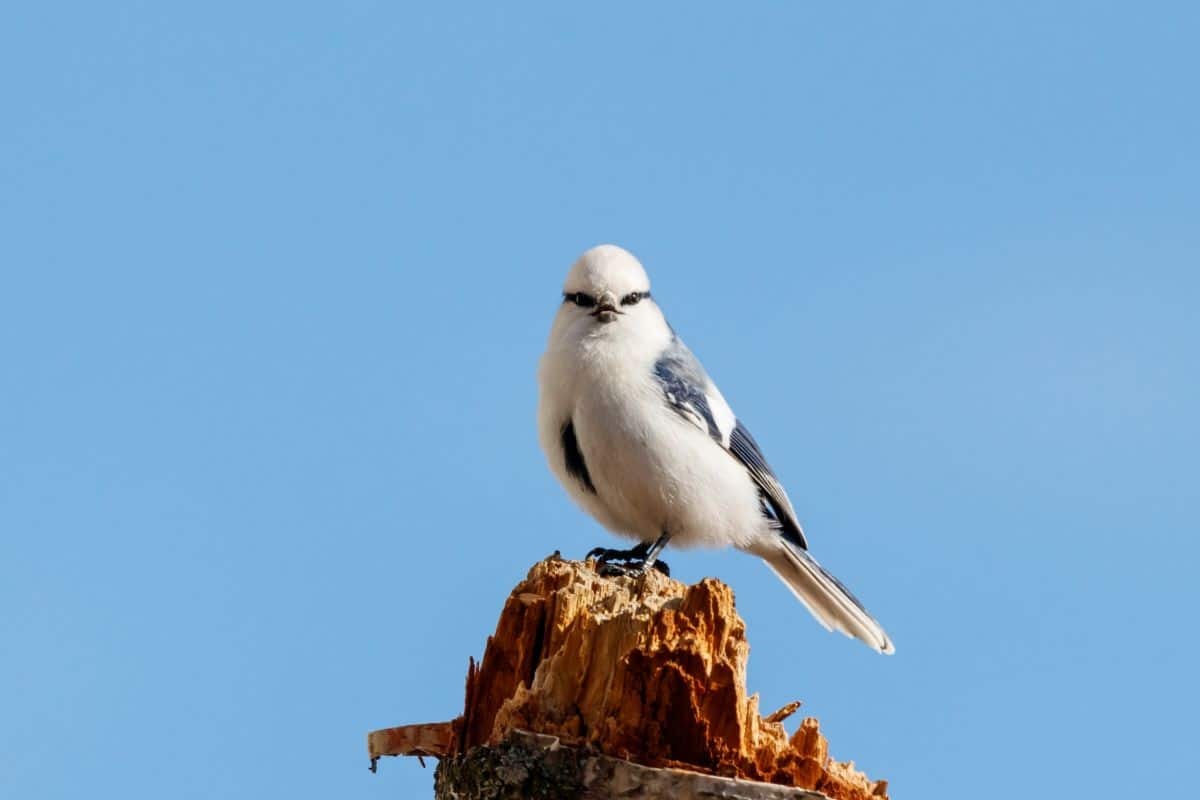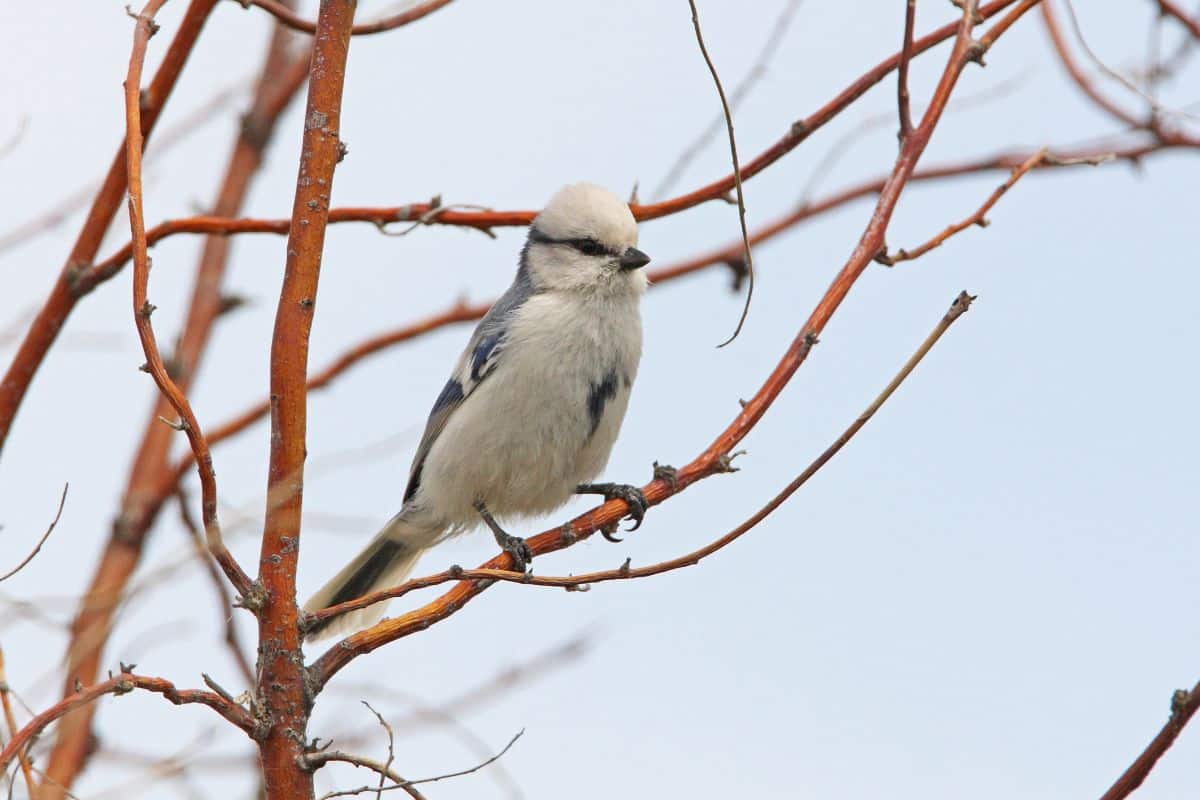Widely recognized across the Asian continent, the Azure Tit is a member of the passerine bird family. The Azure Tit has a white body with bright blue markings across the wings, tail, and back. Most notably, this Azure Tit has a dark line marking through the eye to the back of the head.

Contents
Quick Facts
Before we get deep into our definitive guide of the Azure Tit, let’s look at some basic facts to illuminate the unique qualities of this particular bird:
Classification
Scientific Name: Cyanistes Cyanus
Other Name: Azure Tit
Family: Paridae (Tits)
Conservation Status: Green, least concern
Measurements
Length: 13-14 centimeters
Wingspan: 19-21 centimeters
Weight: 8-10 grams
Other Facts
When to see: The Azure Tit may move westward during the winter months. It can be commonly found in gardens and woodlands in Asia throughout the spring and summer months.
Where to see: The Azure Tit is found throughout the Asian continent and has also been spotted in Western Europe.
Average lifespan: 2-3 years on average
What Does an Azure Tit Look Like?

The Azure Tit has easily definable features. If you’re unsure whether the bird you’ve spotted is an Azure Tit, check for the following markings.
- Snow white chest and underbelly
- A black line marking through the eye and rounding at the shoulders
- Pale blue markings across the back
- Striking, dark blue markings on the wings and tail
Males and females look similar, although juvenile azure tit’s plumage will be a bit duller until they are full grown. Juveniles will still be seen with that black eye band, although their feathers will likely be shades of gray and black.
What Does an Azure Tit Sound Like?
If hiking or walking in the Azure Tit’s habitat, it may be hard to distinguish the songbird’s chirps amongst all of the sounds of the forest. Sounds competing for your ear’s attention may be other birds, insects, or water sources nearby.
The Azure Tit’s song is identifiable with brief, repetitive chirps. Listen for a “dee-dee-dee” or an alternation of “tsi-tsi-tshurr.”
What Does an Azure Tit Eat?
An Azure Tit enjoys a hearty diet of insects, seeds, invertebrates, and even some tiny eggs. Typically, the Azure Tit’s diet changes by season and what is available within their habitat. During the winter, they typically forage for seeds, berries, and nuts. During the spring and autumn time, their diet mainly consists of insects, larvae, and invertebrates.
Where Can I See Azure Tits?

Common throughout Russia and Central Asia, the Azure Tit has a wide range of habitats. Azure Tits are also found in Asia and occasionally in Western Europe.
If you find yourself within the Azure Tit’s range, head to a wooded area. Azure Tits are most commonly found in wooded areas near a water source. You might also find an Azure Tit in marshlands or in large trees near a riverbank.
Signs and Spotting Tips
Once you’re in the Azure Tit’s ideal environment, keep your eyes focused for flashes of brilliant blue wings. Azure Tits are known to be very active birds and can often be seen scaling large trees in search of food.
You may also see them foraging for seeds and other food sources in gardens or near water sources.
How Big is an Azure Tit?
Typically, Azure Tits are 13 centimeters in length and have a wingspan of 19-21 centimeters. The Azure Tit weighs approximately 8 to 10 grams. This is the same size as its closely related counterpart, the Eurasian blue tit. Due to its similar size, behavior pattern, and geographical location, breeding with the Eurasian blue tit sometimes occurs.
How Does an Azure Tit Breed?
Most Azure Tits nest in small holes found within trees and walls. The nest will become home to about ten white eggs with reddish speckles. After an incubation period of about two weeks, both parents will take turns feeding their newly hatched young. The young hatchlings will typically stay within the nest for an additional two weeks to 20 days.
Be prepared for aggressive behavior if you come upon an Azure Tit’s nest. Azure Tits are known to defend their nests quite aggressively, and you will likely be met with hissing and hostile behavior.
How Long Does an Azure Tit Live For?

Like other members of the tit family, a typical lifespan for an Azure Tit is two to three years long.
Do Azure Tits Migrate?
Azure Tits are known as resident birds. A resident bird simply means that Azure Tits do not travel far from their nesting grounds, even in winter. However, some Azure Tits are known to travel small distances in the wintertime, especially if they live in higher elevations.
Azure Tits are also known to occasionally move into Western European countries during winter. However, most Azure Tits simply adjust their diet to whatever is available during winter. During winter, most Azure Tits forage for nuts, seeds, and berries close to their nesting grounds.
Threats and Conservation
Thankfully, Azure Tits are not endangered and are categorized as “least concern” by the International Union for Conservation of Nature.
Like many species, their habitat can be threatened by the continual destruction of woodland areas.
What is a Group of Azure Tits Called?
While there is no formal name given to a group of Azure Tits, there are words for groups of tits.
- Banditry of tits
- A dissimulation of tits
Hybridization in the Wild

Interestingly enough, wild Azure Tits have been known to mate with blue tits. Their offspring is known as a subspecies called “pleskii .”Known in the scientific world as the Parus pleskii, this subspecies behaves just as an Azure Tit or Blue Tit.
The pleskii will have a somewhat smokier underbelly as opposed to the pure white breast of the Azure Tit. It may inherit yellow throat or breast markings from the blue tit and the black band that connects the eye to the shoulder region.
